In this article:
A pilonidal cyst is an abnormal round growth near your tailbone. It can be painful to sit on and may sometimes have discharge. (1)
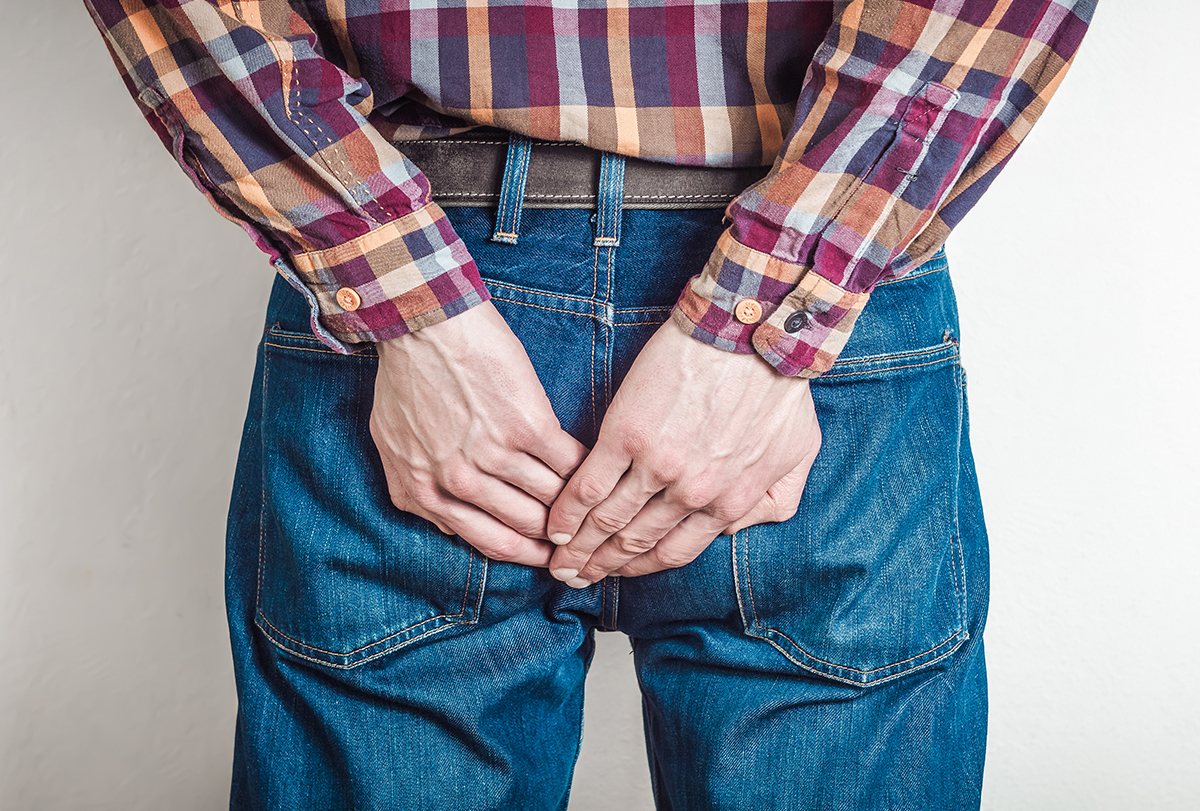
Pilonidal cysts can be an embarrassing problem to go through but are fairly common among men. The good news is several home remedies and preventive tips can help you deal with pilonidal cysts. (2)
What Are Pilonidal Cysts?
Cysts are abnormal growths of tissue that may be filled with fluid and cause pain. Pilonidal cysts are cysts that occur on the pilonidal sinus, which is present at the cleft of your butt. It appears as a bump at the end of your tailbone and can be painful at times.
Home Remedies for Pilonidal Cysts
Here are some home remedies that will help you manage pilonidal cyst:
1. Warm compress
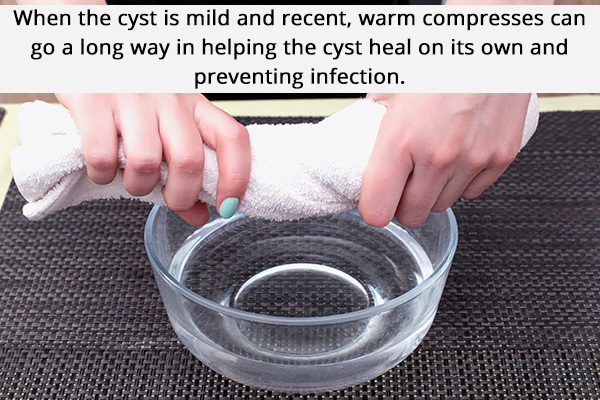
If used when the cyst is mild and recent, warm compresses can go a long way in helping the cyst heal on its own and preventing infection. (3)
How to use:
- Soak a clean cotton cloth in warm water.
- Apply this cloth as a compress to the area.
2. Oregano and tea tree oil
Oregano and tea tree oil are both well known for their anti-inflammatory and antibacterial properties. (4) Terpinen-4-ol, present in tea tree oil, is one of the most potent natural antioxidant compounds that can treat swelling and skin irritation. (5)
How to use:
- Mix 1 teaspoon of coconut oil with a few drops of oregano oil and tea tree oil.
- Apply this oil blend to the cyst once a day.
3. Castor oil
Castor oil is another potent antioxidant oil with antimicrobial and anti-inflammatory properties that can help provide faster relief from pilonidal cysts. (6)
How to use:
- Dip a piece of sterile gauze or cotton ball in warm castor oil.
- Apply this to the cyst for 10–15 minutes twice a day.
4. Manuka honey
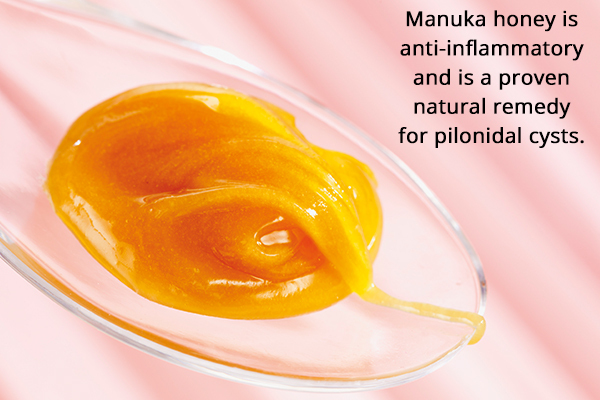
Manuka honey is anti-inflammatory and is a proven natural remedy for pilonidal cysts.
In a recent study conducted on patients suffering from pilonidal cysts, 90% of them were effectively treated with topical application of manuka honey. (7)
How to use:
- You can consume manuka honey extract capsules.
- Pour some manuka honey into a piece of sterile gauze, and apply this to the affected area.
5. Witch hazel
Witch hazel contains large amounts of tannins. Tannins are natural compounds that can help dry out wounds and cysts to hasten the healing process and prevent infections. (8)
How to use:
- Dip a cotton ball in some castor oil mixed with a few drops of witch hazel oil.
- Apply it to the affected area once or twice a day.
6. Aloe vera
Aloe vera gel is a well-known anti-inflammatory and healing remedy used for a number of skin issues. It accelerates wound healing and helps keep infections at bay. (9)
How to use:
- Add a few drops of olive oil to 1 teaspoon of aloe vera gel and mix well.
- Apply this paste to the affected area once or twice a day.
7. Licorice with hot oil treatment
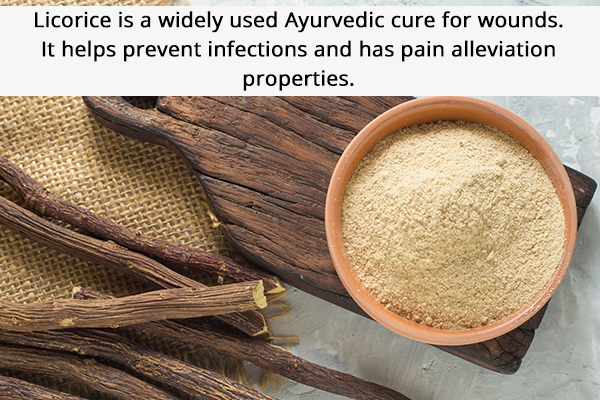
Licorice (Glycyrrhiza glabra) is a widely used Ayurvedic cure for wounds. It helps prevent infections and has pain-alleviating properties. (10)
How to use:
- Mix some castor oil and coconut oil together and heat the mixture.
- Add some powdered licorice root to this oil blend. Let it cool.
- Apply this paste to the pilonidal cyst once or twice a day. (10)
8. Burdock leaves and olive oil
Burdock leaves contain anti-inflammatory and antimicrobial compounds that can help treat a pilonidal cyst faster.
Some research studies have proven the effectiveness of steeped burdock leaves in healing wounds. (11)
How to use:
- Put dried burdock leaves in a glass jar.
- Pour some olive oil into the jar to soak these leaves and seal the jar.
- Let it sit in the sun for a couple of weeks.
- Strain the oil and heat it for a few minutes before storing it in a container.
- Apply this burdock-infused olive oil to the affected area once or twice a day.
9. Turmeric paste
Turmeric contains curcumin, an antioxidant compound with potent anti-inflammatory and antibacterial properties. It can help relieve the pain and swelling caused by a pilonidal cyst and also prevent infections. (12)
How to use:
- Mix 1 teaspoon of turmeric powder with a few drops of coconut oil to make a paste.
- Apply this paste to the affected area.
What Are the Causes of Pilonidal Cysts?
The common causes of pilonidal cysts are:
- Long periods of sitting
- Obesity
- Ingrown hair
- Heredity
- Constantly wearing skin-tight clothing
- Improper hygiene, which may cause infection in the cysts (13)
Who Gets This Disorder?
Pilonidal cysts are more frequently reported in men, though they can also occur in women.
People who do not move around much and who sit for long periods are more likely to develop pilonidal cysts. Those with thick or stiff hair can also be more likely to have ingrown hair that can cause a pilonidal cyst.
Signs and Symptoms of Pilonidal Cysts
Pilonidal cysts can appear as tiny pimples at the top of your buttocks and gradually increase in size. Symptoms may include:
- Pain and tenderness
- Inflammation
- Pus discharge and fever if the cyst is infected
Diagnosing Pilonidal Cysts
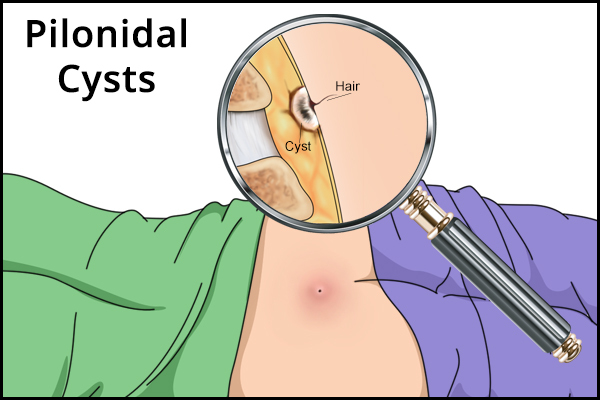
Your dermatologist can diagnose a pilonidal cyst simply by observing or touching the bump. In some cases, they may ask you to undergo an MRI or CT scan to confirm the diagnosis.
Treatment for Pilonidal Cysts
Treatment for pilonidal cysts depends on the severity of your condition and the symptoms. Most doctors will follow this treatment plan:
1. Maintaining proper hygiene
Your doctor will advise you to keep the area around the cyst clean and to use a hair removal cream to avoid ingrown hairs. In some cases, the cyst may resolve on its own in a few weeks. (14)(15)
2. Antibiotic treatment
Your doctor might prescribe an antibiotic course for a week or two. This can help treat mild infection and inflammation. (16)
3. Surgery
A pilonidal cyst that does not heal on its own or keeps on recurring may require surgical removal. The surgery is a simple procedure and can be performed easily, but complete recovery may take a few months. (17)
Lifestyle Changes to Prevent Pilonidal Cysts

If your daily routine requires you to sit in one place for long hours at a time, make sure to take short breaks once in a while to stretch and walk.
Maintaining proper hygiene is also key to preventing bacterial infections.
Most-Asked Questions About Pilonidal Cysts
Can I pop a tailbone cyst at home?
No. You should not try to pop a cyst by yourself as it can cause severe infection.
What ointment is good for a pilonidal cyst?
Metronidazole antibiotic ointment is the most frequently prescribed topical treatment for pilonidal cysts.
Can I use DMSO for pilonidal cysts?
Some people suggest using DMSO (dimethyl sulfoxide) can help heal pilonidal cysts faster. However, this has not been proven by scientific studies.
Final Word
Pilonidal cysts can be an annoying and painful problem to go through. You can try some of the home remedies given above to alleviate your discomfort. It is highly recommended to seek medical treatment for pilonidal cysts and to ask for your dermatologist’s approval before applying anything to the cyst.
- Was this article helpful?
- YES, THANKS!NOT REALLY


